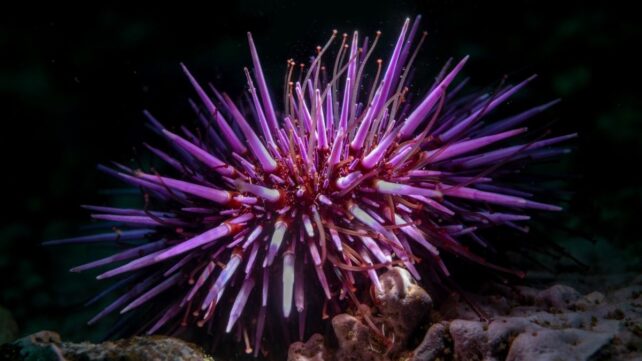Sea urchins may just look like a ball of spikes waiting to be stepped on at the tide pool, but there's much more to these barbed beasts than just roe and teeth.
New research reveals sea urchin nervous systems are far more complex than we knew. These creatures, it turns out, possess 'all-body brains' and, at least in their genetic layout, they are remarkably similar to our own.
A team of scientists led by developmental biologist Periklis Paganos from Stazione Zoologica Anton Dohrn in Italy made the discovery while investigating metamorphosis in purple sea urchins (Paracentrotus lividus), which transform from free-swimming, planktonic larvae to the mature, spine-encrusted form we're more familiar with.
Related: Starfish Are Basically Bodiless Heads Crawling Around The Ocean, Scientists Say
Urchin puberty is more drastic than a butterfly's, with the sea creatures crossing some of the most deep-rooted boundaries of animal evolution in the process.
As larvae, they follow a body plan with two roughly mirrored halves, known as bilateral symmetry. But as they transform into adults, sea urchins take on a form more similar to jellyfish and starfish, known as radial symmetry because it is roughly mirrored in five sections from the center.
This young adult stage, it turns out, comes with a remarkable assortment of neuronal cell types, which form an integrated system throughout the urchin's entire body. And these aren't nerves extending from a brain: they are, in essence, the creature's brain.
The researchers created a cell atlas of the newly matured sea urchin by mapping out which genes were switched on in which cells. Their analysis revealed that, while many of their body cells were engaging similar genes either side of metamorphosis, their neurons underwent a substantial shift.

"Although the same genetic toolkit is used to generate neurons, the outcomes of the neurogenic program differ substantially between the two analyzed life stages," the researchers report.
The diversity of neurons in a young adult sea urchin fundamentally upends the idea that echinoderm central nervous systems are 'simple' just because they lack a centralized brain.
More than half of the cell clusters mapped in the juvenile cell atlas comprised of neurons, which expressed a broad range of molecular signatures. You might be familiar with some of them: dopamine, serotonin, GABA, glutamate, histamine, and neuropeptides.
This, the researchers say, suggests purple sea urchins have a nervous system far more sophisticated than a decentralized nerve net, a mere network of interconnected neurons and ganglia.
In fact, the researchers even describe this nervous system as an "all-brain" rather than a "no-brain" state, with the entire body plan being akin to a vertebrate head, brimming with complex neurons.
"Our results show that animals without a conventional central nervous system can still develop a brain-like organization," says evolutionary biologist Jack Ullrich-Lüter, from the Natural History Museum of Berlin.
"This fundamentally changes how we think about the evolution of complex nervous systems."
This research was published in Science Advances.

